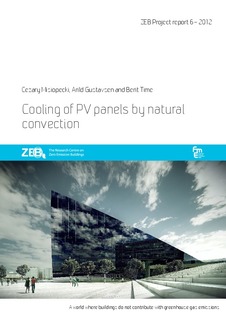| dc.description.abstract | Building Integrated Photovoltaic (BIPV) is an important source of renewable energy production for Zero Emission Buildings, even in Norwegian climate. In the planned Powerhouse 1 building at Brattøra in Trondheim the idea to reach a zero emission building level is to use PVs as a roofing material covering the entire roof. Challenges and questions raised in the design process of this building have motivated the work reported here.
Photovoltaic (PV) panels directly convert solar radiation into electricity with peak efficiency in the range of 9–12%. It means that more than 80% of the solar radiation falling on PV cells is not converted to electricity, but either reflected, transmitted or absorbed. Reflected and transmitted radiation is relatively small in comparison to absorbed radiation. Part of absorbed energy is converted into electricity and the rest is change to the heat, which increases unit temperature. Higher temperature of unit has negative influence on PV panel’s efficiency.
Conducted study focuses on finding the best cooling strategy for PV panels which simultaneously perform as a roof finishing layer of large roof and test it by numerical methods. Comparison analysis of different air gap widths for natural convection cooling was done using numerical model. The results shown that 5 cm wide air gap is not sufficient to provide natural convection cooling of 70 meter-long rooftop made of PV panels. Moreover, increasing air gap width over the 25 cm seems to not giving substantial improvements of natural convection cooling.
The developed model is good starting point for further study in this area. Findings and experience gained during this study hopefully can be transferred into more precise 3D modeling of this case. | |
